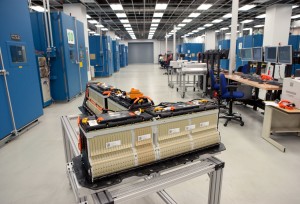The National Highway Traffic Safety Administration (NHTSA) is considering adopting a new set of procedures for tow trucks and wrecking yards to follow when dealing with severely crashed electric cars.
The new guidelines may be implemented after an incident in which a 2011 Chevrolet Volt caught fire in an NHTSA open storage yard three weeks after it was subjected to an official side-impact test.
The problem
Just like a gas tank, an electric car's battery pack stores energy. In a gas tank, the energy is contained within the gasoline. In a battery, the energy is stored chemically within the battery, changing to electrical energy when the battery is discharged.
Under controlled circumstances, this doesn’t pose a safety risk, but if you mechanically short out parts of the battery or damage a cell, the cold, harsh laws of thermodynamics come into play.
That normally equates to lots of stored chemical energy trying to escape from the battery as electrical energy, increasing entropy in the system and ultimately heating the battery up.
In that situation, a fire is predictable, just like a gasoline car with a ruptured gasoline tank and a handy source of ignition.

Car crash accident
The solution
When first responders attend a car crash involving fossil-fuel powered cars, they don't drain the fuel tanks. But after the wrecked car is hauled to a wrecking yard or other storage, the fuel tanks are usually drained.
To date, electric cars have been treated differently, with first responders trained to find the safety-disconnect plug for the battery pack that's built into every production electric car. That allows them to break the physical connection between the car’s battery pack and the rest of the car.
But that step assumes that the car’s battery pack is internally safe, and has suffered no major deformation or physical intrusion. As the NHTSA fire shows, when the battery pack itself has been damaged internally, disconnecting the battery pack may not help in the long run.
Which brings us to the solution now being considered by the NHTSA: draining the fluid or paste-like electrolyte from the car’s battery pack. Since the electrolyte is responsible for allowing current to flow through the battery, draining it would essentially flatten the battery pack, rendering it benign.
In other words, the battery pack of an electric car would be drained just as the gasoline tank in a crashed non-electric car would be, reducing the fire risk over the long term.
At the moment, draining the pack would require a specialist team at the scene of major accidents or at wrecking yards, to remove the electrolyte chemicals from the battery and dispose of them properly. But according to The Detroit Free Press, dealerships and even first responders may carry specialist tools to safely puncture and drain a battery pack to eliminate fire risks in the future.
Only a precaution, electric cars still safe

Lithium-ion battery pack for 2011 Chevrolet Volt
While the NHTSA is openly considering new guidelines to be issued to wrecking yards and first responders on dealing with electric cars, the organization doesn’t believe electric cars are any more dangerous than gasoline cars when it comes to severe crashes. In a statement last week the agency reiterated that electric and plug-in hybrid cars are no different from gasoline cars in a serious crash: All have some risk of fire.
It’s also important to remember that in the first year of sales, we’ve only seen two other fires involving Chevrolet Volts: one in Connecticut, and one in North Carolina, and none that we can think of involving other electric cars. In both cases, investigators have concluded that the destroyed Volts were not the cause of either blaze.
We should also note that in the case of the NHTSA crash-tested Volt fire, while the NHTSA drained the gasoline tank of the plug-in hybrid, it did not de-energize the battery pack following the impact test, something which GM recommends is done but did not inform the NHTSA to do.
We’re glad to see that the electric auto industry is tackling the subject of battery fires seriously, even if the numbers of electric car fires are negligible compared to the numbers of gasoline-car fires every year.
After all, as any automaker will attest to, the safer a car becomes, the more desirable it is.
+++++++++++













